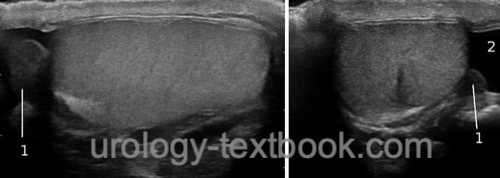You are here: Urology Textbook > Urologic examinations > Imaging > Testicular ultrasound
Testicular Ultrasound Imaging and Doppler Sonography
Testicular and scrotal ultrasound imaging is indicated in patients with testicular pain (acute scrotum), trauma, scrotal masses, male infertility, hypogonadism, gynecomastia and after scrotal surgery. The Doppler ultrasound is additionally performed in patients with an acute scrotum (differential diagnosis of testicular torsion), varicocele and for unclear tumors to detect internal perfusion.
Examination Technique
A high-resolution linear probe of 7.5–10 MHz is used for imaging of the scrotum. In the supine position, the testicles are fixed with a towel or by the hands of the patient. The testicles and scrotal content are systematically examined in longitudinal and transversal sections.
Normal Findings
Testicular size:
In adults: length 4–5 cm, thickness 2–3 cm, volume 12–30 ml. The volume is calculated using the following formula:
Testicular volume = Length × Width × Height × 0,5
Echo architecture:
The testicle shows a homogeneous echo pattern, the tunica albuginea is thin and echogenic. The radial arrangement of the lobules can be identified. The epididymis is clearly distinguishable from the testes fig. normal testicular ultrasound.
 |
Doppler Ultrasonography of the Testis
Technical settings:
For a reliable identification of the testicular vessels, a high quality linear probe with a frequency of 10 MHz or above should be used. The settings are set expecting a low flow rate and low Nyquist limit, a wall filter should be turned off.
Normal findings:
It is crucial to perform the Doppler ultrasound examination with unequivocal intratesticular vessels. Capsular vessels may be misidentified as vessels of the scrotal wall. With a correct technical setting, a Doppler signal is always detectable from the testicular parenchyma. Normally, the RI in the testes (resistive index) is below 0.7 due to the relatively high end-diastolic blood flow. Higher RI values (decreasing diastolic blood flow) are signs of partial testicular torsion.
| Penis ultrasound | Index | TRUS |
Index: 1–9 A B C D E F G H I J K L M N O P Q R S T U V W X Y Z
References
Singer u.a. 2006 SINGER, Eric A. ; GOLIJANIN, Dragan J. ; DAVIS, Robert S. ; DOGRA, Vikram: What’s new in urologic ultrasound?In: Urol Clin North Am
33 (2006), Aug, Nr. 3, S. 279–286
 Deutsche Version: Sonographie der Hoden
Deutsche Version: Sonographie der Hoden
Urology-Textbook.com – Choose the Ad-Free, Professional Resource
This website is designed for physicians and medical professionals. It presents diseases of the genital organs through detailed text and images. Some content may not be suitable for children or sensitive readers. Many illustrations are available exclusively to Steady members. Are you a physician and interested in supporting this project? Join Steady to unlock full access to all images and enjoy an ad-free experience. Try it free for 7 days—no obligation.
New release: The first edition of the Urology Textbook as an e-book—ideal for offline reading and quick reference. With over 1300 pages and hundreds of illustrations, it’s the perfect companion for residents and medical students. After your 7-day trial has ended, you will receive a download link for your exclusive e-book.